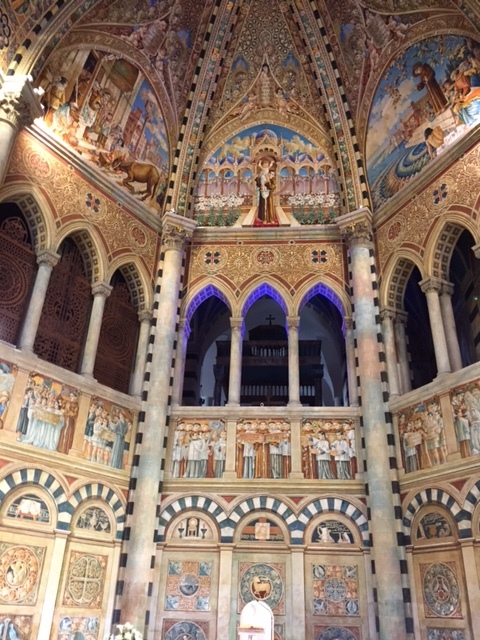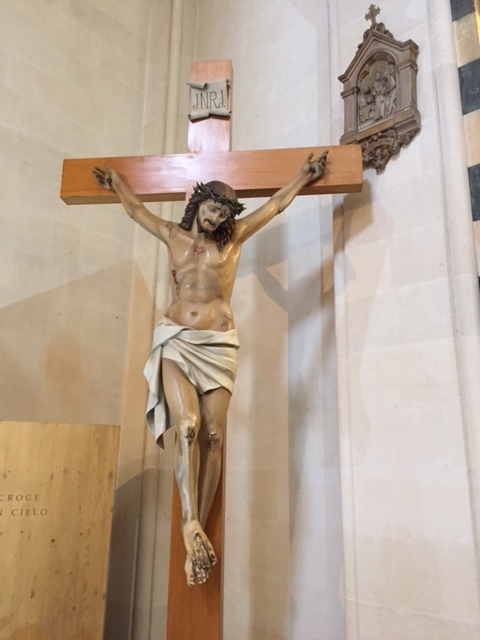The St. Nicholas Pilgrimage formally began Wednesday, April 26. All of 37 of us on this journey had gathered at the hotel where we are staying in Lecce, Italy. We had a welcome reception and it was good to see again others we had travelled with before. Peter Sills thinks he has led at least 27 such pilgrimages, he's lost count of the actual number - each to a different place. Two people have travelled on 11 of these pilgrimages. Four of our group have done three with Peter.
At this reception Peter said something about each person. Six are from the States, four from Australia and the rest from Britain. After the reception, we shared a meal together. We are encouraged to eat with a different person(s) at each meal. Likely when the custom of pilgrimages began, people did share food together. Then, more likely out of survival needs. Now more out of community building.
When we think of things that are old, from the perspective of living in the States, somewhere between two and three hundred years seems old. Nicholas, a bishop in the church in what we now know as Turkey, was one of the people who signed the Nicene Creed early in the Fourth Century.
Lecce is a city that traces its roots back to early in the Roman era - if not before. Rather than write that information here, I am putting four pictures - one of the ancient Roman Coliseum-like ruin that stands exposed in the central plaza of the city, one showing the coat of arms of the city, and two explaining the origin and significance of this coat of arms.
Lecce, like the other ancient cities we will visit, is full of narrow winding streets that were laid out centuries ago. It is said that the first bishop of Lecce was appointed by St. Paul in the year 57. The city if full of churches, several of which we visited.
As I wrote in an earlier post, there is a difference between traveling as a tourist and traveling as a pilgrim. To travel as a pilgrim is, among other, things, to use a figure from the history of one's religion and travel a route he or she might have traveled to a destination that currently and historically has honored this person.
St. Nicholas is the person from ancient history we are focusing on, thanks to the research and writings of Peter Sills. Daily, he reads- as part of one of our worship rituals or as we travel historical aspects of St. Nicholas's life - stories about him, historical records and Peter's own story.
Peter helps us focus our intention by carefully crafted religious rituals - Evening Prayer, Morning Prayer, the Eucharist celebration and Compline.
At the end of our first full day in Lecce we had Evening Prayer in one of the most beautiful Romanesque Churches I have ever seen. The chancel and transepts were painted, in a two year period, by one man. This church is connected to the Franciscan order, hence one of the transepts is completed devoted to St. Francis. Just being in this space was moving on its own. Peter's leadership in the service and his reading made it more so. I'm hoping you can appreciate a smidgen of it from the photographs. The church is known as Chiesa Sant' Antonio a Fulgenzo.
I also saw in this church one of the most unusual crucifixes I've seen. Can you guess what sets it apart?
One just doesn't wander into or onto a pilgrimage route. Intention is required. This is true of doing any work consciously to grow in peace, love, joy and power. At some point we have to decide whether or not to live and die smaller, as Kathleen Singh puts it, "if we are willing to leave this unimaginably precious gift of a human life unopened?"
As far as I can find out, every tradition has what the Buddhist call "the noble path." We do not awaken simply because we wish to. We maintain and strengthen our intention in making a commitment to a path and joining others in following it. A pilgrimage like the one we are on is symbolic of this intention. About which I will have more to say as we continue the journey.







